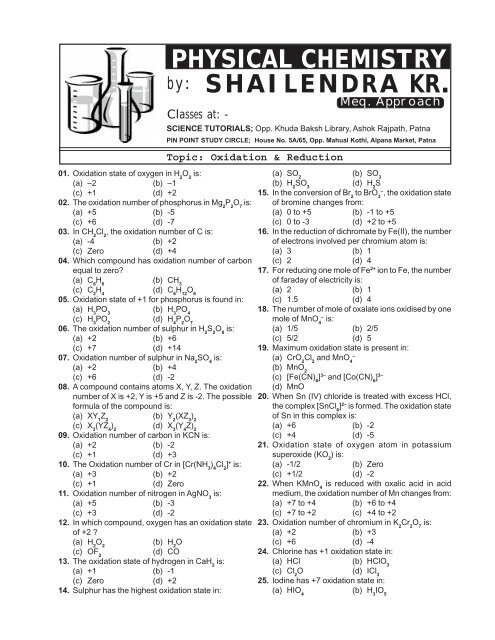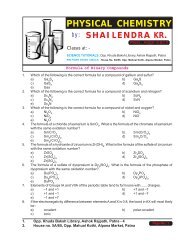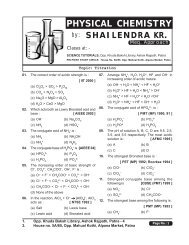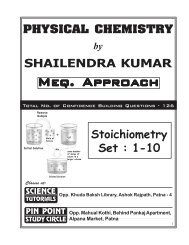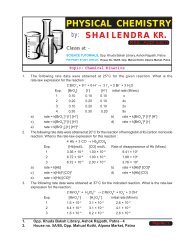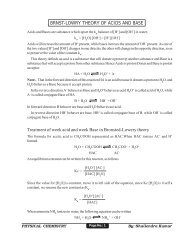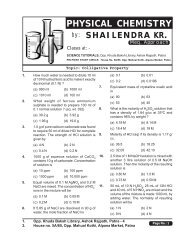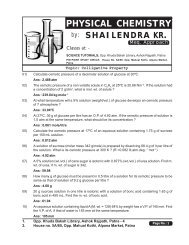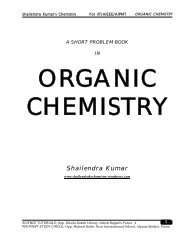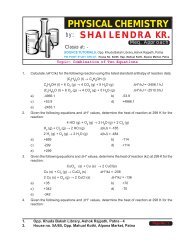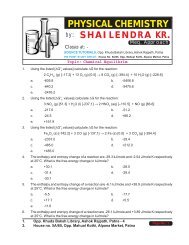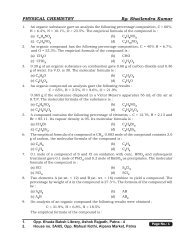Oxidation reduction (p. bahadur obj.) - Shailendra Kumar Chemistry
Oxidation reduction (p. bahadur obj.) - Shailendra Kumar Chemistry
Oxidation reduction (p. bahadur obj.) - Shailendra Kumar Chemistry
You also want an ePaper? Increase the reach of your titles
YUMPU automatically turns print PDFs into web optimized ePapers that Google loves.
PHYSICAL CHEMISTRY<br />
by: SHAILENDRA KR.<br />
Classes at: -<br />
SCIENCE TUTORIALS; Opp. Khuda Baksh Library, Ashok Rajpath, Patna<br />
PIN POINT STUDY CIRCLE; House No. 5A/65, Opp. Mahual Kothi, Alpana Market, Patna<br />
Topic: <strong>Oxidation</strong> & Reduction<br />
01. <strong>Oxidation</strong> state of oxygen in H 2<br />
O 2<br />
is:<br />
(a) –2 (b) –1<br />
(c) +1 (d) +2<br />
02. The oxidation number of phosphorus in Mg 2<br />
P 2<br />
O 7<br />
is:<br />
(a) +5 (b) -5<br />
(c) +6 (d) -7<br />
03. In CH 2<br />
Cl 2<br />
, the oxidation number of C is:<br />
(a) -4 (b) +2<br />
(c) Zero (d) +4<br />
04. Which compound has oxidation number of carbon<br />
equal to zero<br />
(a) C 6<br />
H 6<br />
(b) CH 3<br />
(c) C 2<br />
H 4<br />
(d) C 6<br />
H 12<br />
O 6<br />
05. <strong>Oxidation</strong> state of +1 for phosphorus is found in:<br />
(a) H 3<br />
PO 3<br />
(b) H 3<br />
PO 4<br />
(c) H 3<br />
PO 2<br />
(d) H 4<br />
P 2<br />
O 7<br />
06. The oxidation number of sulphur in H 2<br />
S 2<br />
O 8<br />
is:<br />
(a) +2 (b) +6<br />
(c) +7 (d) +14<br />
07. <strong>Oxidation</strong> number of sulphur in Na 2<br />
SO 4<br />
is:<br />
(a) +2 (b) +4<br />
(c) +6 (d) -2<br />
08. A compound contains atoms X, Y, Z. The oxidation<br />
number of X is +2, Y is +5 and Z is -2. The possible<br />
formula of the compound is:<br />
(a) XY 1<br />
Z 2<br />
(b) Y 2<br />
(XZ 3<br />
) 2<br />
(c) X 3<br />
(YZ 4<br />
) 2<br />
(d) X 3<br />
(Y 4<br />
Z) 2<br />
09. <strong>Oxidation</strong> number of carbon in KCN is:<br />
(a) +2 (b) -2<br />
(c) +1 (d) +3<br />
10. The <strong>Oxidation</strong> number of Cr in [Cr(NH 3<br />
) 4<br />
Cl 2<br />
] + is:<br />
(a) +3 (b) +2<br />
(c) +1<br />
(d) Zero<br />
11. <strong>Oxidation</strong> number of nitrogen in AgNO 3<br />
is:<br />
(a) +5 (b) -3<br />
(c) +3 (d) -2<br />
12. In which compound, oxygen has an oxidation state<br />
of +2 <br />
(a) H 2<br />
O 2<br />
(b) H 2<br />
O<br />
(c) OF 2<br />
(d) CO<br />
13. The oxidation state of hydrogen in CaH 2<br />
is:<br />
(a) +1 (b) -1<br />
(c) Zero (d) +2<br />
14. Sulphur has the highest oxidation state in:<br />
Meq. Approach<br />
(a) SO 2<br />
(b) SO 3<br />
(b) H 2<br />
SO 3<br />
(d) H 2<br />
S<br />
15. In the conversion of Br 2<br />
to BrO 3–<br />
, the oxidation state<br />
of bromine changes from:<br />
(a) 0 to +5 (b) -1 to +5<br />
(c) 0 to -3 (d) +2 to +5<br />
16. In the <strong>reduction</strong> of dichromate by Fe(II), the number<br />
of electrons involved per chromium atom is:<br />
(a) 3 (b) 1<br />
(c) 2 (d) 4<br />
17. For reducing one mole of Fe 2+ ion to Fe, the number<br />
of faraday of electricity is:<br />
(a) 2 (b) 1<br />
(c) 1.5 (d) 4<br />
18. The number of mole of oxalate ions oxidised by one<br />
–<br />
mole of MnO 4<br />
is:<br />
(a) 1/5 (b) 2/5<br />
(c) 5/2 (d) 5<br />
19. Maximum oxidation state is present in:<br />
–<br />
(a) CrO 2<br />
Cl 2<br />
and MnO 4<br />
(b) MnO 2<br />
(c) [Fe(CN) 6<br />
] 3– and [Co(CN) 6<br />
] 3–<br />
(d) MnO<br />
20. When Sn (IV) chloride is treated with excess HCl,<br />
the complex [SnCl 6<br />
] 2– is formed. The oxidation state<br />
of Sn in this complex is:<br />
(a) +6 (b) -2<br />
(c) +4 (d) -5<br />
21. <strong>Oxidation</strong> state of oxygen atom in potassium<br />
superoxide (KO 2<br />
) is:<br />
(a) -1/2<br />
(b) Zero<br />
(c) +1/2 (d) -2<br />
22. When KMnO 4<br />
is reduced with oxalic acid in acid<br />
medium, the oxidation number of Mn changes from:<br />
(a) +7 to +4 (b) +6 to +4<br />
(c) +7 to +2 (c) +4 to +2<br />
23. <strong>Oxidation</strong> number of chromium in K 2<br />
Cr 2<br />
O 7<br />
is:<br />
(a) +2 (b) +3<br />
(c) +6 (d) -4<br />
24. Chlorine has +1 oxidation state in:<br />
(a) HCl (b) HClO 3<br />
(c) Cl 2<br />
O (d) ICl 3<br />
25. Iodine has +7 oxidation state in:<br />
(a) HIO 4<br />
(b) H 3<br />
IO 5
(c) H 5<br />
IO 6<br />
(d) All of these<br />
26. Which reaction indicates the oxidising behaviour of<br />
H 2<br />
SO 4<br />
<br />
(a) 2PCl 5<br />
+ H 2<br />
SO 4<br />
––––→ 2POCl 3<br />
+ 2HCl + SO 2<br />
Cl 2<br />
(b) 2NaOH + H 2<br />
SO 4<br />
––––→ Na 2<br />
SO 4<br />
+ 2H 2<br />
O<br />
(c) NaCl + H 2<br />
SO 4<br />
––––→ NaHSO 4<br />
+ HCl<br />
(d) 2HI + H 2<br />
SO 4<br />
––––→ I 2<br />
+ SO 2<br />
+ 2H 2<br />
O<br />
27. If three electrons are lost by a metal ion M 3+ , its final<br />
oxidation number will be:<br />
(a) Zero (b) +6<br />
(c) +2 (d) +4<br />
28. <strong>Oxidation</strong> number of N in N 3<br />
H is:<br />
(a) -3 (b) +3<br />
(c) Zero (d) -1/3<br />
29. The oxidation number of N in NH 3<br />
is:<br />
(a) -3 (b) +3<br />
(c) Zero (d) 5<br />
30. <strong>Oxidation</strong> number of S in S 2<br />
Cl 2<br />
is:<br />
(a) +1 (b) +6<br />
(c) Zero (d) -1<br />
31. The oxidation number of Fe in K 4<br />
Fe(CN) 6<br />
is:<br />
(a) +2 (b) +3<br />
(c) +4 (d) +6<br />
–<br />
32. HCO 3<br />
contains carbon in the oxidation state:<br />
(a) +5 (b) +1<br />
(c) +4<br />
(d) Zero<br />
33. In nitric oxide (NO) the oxidation state of N is:<br />
(a) -2 (b) +1<br />
(c) -1 (d) +2<br />
34. In which of the following N has lowest oxidation<br />
number <br />
(a) NO (b) NO 2<br />
(c) N 2<br />
O (d) N 2<br />
O 5<br />
2–<br />
35. <strong>Oxidation</strong> number of S in S 2<br />
O 3<br />
is:<br />
(a) +2 (b) -2<br />
(c) 4<br />
(d) Zero<br />
36. <strong>Oxidation</strong> number of Fe in K 3<br />
[Fe(CN) 6<br />
] is:<br />
(a) +2 (b) +3<br />
(c) +4 (d) +1<br />
37. The maximum oxidation number of transition metals<br />
may be:<br />
(a) +4 (b) +6<br />
(c) +8 (d) +10<br />
38. Carbon is in the lowest oxidation state in :<br />
(a) CH 4<br />
(b) CCl 4<br />
(b) CO 2<br />
(d) CF 4<br />
39. <strong>Oxidation</strong> state of oxygen is -1 in the compound :<br />
(a) NO 2<br />
(b) MnO 2<br />
(c) PbO 2<br />
(d) Na 2<br />
O 2<br />
40. In sodium hydride, oxidation state of sodium is:<br />
(a) Zero (b) +1<br />
(c) -1 (d) +2<br />
41. In MgH 2<br />
, <strong>Oxidation</strong> number of hydrogen is:<br />
(a) -1 (b) +1<br />
(c) -2 (d) +2<br />
42. The oxidation number of iodine in IF 5<br />
is:<br />
(a) +5 (b) -5<br />
(c) -1 (d) +1<br />
43. What is the ox. no. of Mn in K 2<br />
MnO 4<br />
<br />
(a) +4 (b) +6<br />
(c) +2 (d) +8<br />
44. With which element oxygen shows positive oxidation<br />
state in its compounds<br />
(a) Na<br />
(b) Cl<br />
(c) N<br />
(d) F<br />
45. The oxidation number of Mn in MnO 2<br />
is:<br />
(a) +4 (b) +6<br />
(c) +2 (d) -4<br />
46. The oxidation number of P in KH 2<br />
PO 2<br />
is:<br />
(a) +1 (b) +3<br />
(c) -3 (d) +5<br />
47. The oxidation number of Cl in KClO 3<br />
is:<br />
(a) +5 (b) -5<br />
(c) +3 (d) -3<br />
48. One mole of N 2<br />
H 4<br />
loses 10 mole of electrons to form<br />
a new compound Y, Assuming that all nitrogen<br />
appears in the new compound, what is the oxidation<br />
number of nitrogen in Y (There is no change in the<br />
oxidation state of hydrogen)<br />
(a) -3 (b) +3<br />
(c) +5 (d) +1<br />
49. The reaction is balanced if,<br />
5H 2<br />
O 2<br />
+ XClO 2<br />
+ 2OH – ––––→ XCl – + YO 2<br />
+ 6H 2<br />
O<br />
(a) X = 5, Y = 2 (b) X = 2, Y = 5<br />
(c) X = 4, Y = 10 (d) X = 5, Y = 5<br />
50. The oxidation state of nitrogen in NH 4<br />
NO 3<br />
is:<br />
(a) -3 and +5 (b) +3 and +5<br />
(c) +5 (d) +3<br />
51. The oxidation number of nitrogen in NH 2<br />
OH is:<br />
(a) +1 (b) -1<br />
(c) -3 (d) -2<br />
52. <strong>Oxidation</strong> number of As atom in H 3<br />
AsO 4<br />
is:<br />
(a) +5 (b) +6<br />
(c) +4 (d) -3<br />
53. <strong>Oxidation</strong> number of chlorine in HOCl is:<br />
(a) Zero (b) -1<br />
(c) +1 (d) +2<br />
54. Nitrogen has fractional oxidation number in:<br />
(a) N 2<br />
H 4<br />
(b) NH 4<br />
(c) HN 3<br />
(d) N 2<br />
F 2<br />
2–<br />
55. <strong>Oxidation</strong> of thiosulphate(S 2<br />
O 3<br />
) ions by iodine gives<br />
– 2–<br />
(a) SO 3<br />
(b) SO 4<br />
2– 2–<br />
(c) S 4<br />
O 6<br />
(d) S 2<br />
O 8<br />
56. The charge on cobalt in [Co(CN) 6<br />
] 3– is:<br />
(a) -6 (b) +3<br />
(c) -3 (d) +6<br />
57. The maximum oxidation state of osmium is :<br />
(a) +7 (b) +8<br />
(c) +10 (d) +6<br />
58. In the compound KMnO 4<br />
and K 2<br />
Cr 2<br />
O 7<br />
, the highest<br />
oxidation state is of the element:<br />
(a) K<br />
(b) Mn<br />
(c) Cr<br />
(d) O<br />
59. The maximum oxidation state of chromium is:<br />
(a) +6 (b) +4<br />
(c) +8 (d) +7
PHYSICAL CHEMISTRY<br />
1. b<br />
2. a<br />
3. c<br />
4. d<br />
5. c<br />
6. b<br />
7. c<br />
8. c<br />
9. a<br />
10. a<br />
11. a<br />
12. c<br />
13. b<br />
14. b<br />
15. a<br />
16. a<br />
17. a<br />
18. c<br />
19. a<br />
20. c<br />
21. a<br />
22. c<br />
23. c<br />
24. c<br />
25. d<br />
26. d<br />
27. b<br />
28. d<br />
29. a<br />
30. a<br />
A N S W E R S<br />
31. a<br />
32. c<br />
33. d<br />
34. c<br />
35. a<br />
36. b<br />
37. c<br />
38. a<br />
39. d<br />
40. b<br />
41. a<br />
42. a<br />
43. b<br />
44. d<br />
45. a<br />
46. a<br />
47. a<br />
48. b<br />
49. b<br />
50. a<br />
51. b<br />
52. a<br />
53. c<br />
54. c<br />
55. c<br />
56. b<br />
57. b<br />
58. b<br />
59. a<br />
by: SHAILENDRA KR.<br />
1. Opp. Khuda Baksh Library, Ashok Rajpath, Patna - 4<br />
2. House no. 5A/65, Opp. Mahual Kothi, Alpana Market, Patna<br />
Page No.: 3


